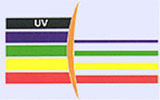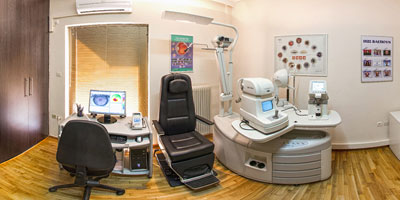Sun and eyes. Ways to protect.
The sun’s rays are a source of life but they can prove dangerous especially in the summer when exposure to the sun is prolonged. The effect of the sun on our eyes is harmful. The sun may be responsible in the long term for a lot of diseases and for the ageing of our eyes. So it is essential that we protect them from the sun’s rays with the right kind of sunglasses, a hat etc.
But what are the right kind of sunglasses? Simple absorbent glasses don’t protect against all types of rays. In contrast, the newer melanin lenses, blue blockers and polarised sun lenses offer the greatest protection for our eyes. So, what do you need to know about the sun and what are the modern ways of protecting our eyes better?
What are the harmful rays of the sun?
We need to know that the sun’s radiation is made up of three types of ray:
1) infrared rays (wavelength 700-2300nm), responsible for raising the temperature in the cells.
2) ultraviolet rays (UV with wavelength 190-400nm) chiefly responsible for pathologies of the exterior layers of the eye and crystalline lens (e.g. cataracts) and
3) high energy rays in the visible spectrum (HEV - High Energy Visible with a wavelength of 400 - 700nm) which correspond to blue-violet light and are responsible for pathologies of the retina (macular degeneration). We do not often hear about the latter even though they are the most dangerous for our eyes as they cause irreversible damage and the usual absorbent sunglasses we wear do not adequately protect us.
What damage does sunlight do to our eyes?
The sun’s rays are responsible for a range of eye pathologies which occur after years of exposure to the sun. So don’t forget that the sun’s effect is cumulative.
Starting from the outer layers of the eye, the eyelids are the ones where all the rays end up and consequently the aging of their sensitive thin skin comes faster than that of the rest of the skin. The result is early wrinkles around the eyes. Also the appearance of tumors on the eyelids, such as epitheliomas and melanomas which require timely surgical removal. The conjunctiva, ie the white layer of the eye, is relatively easily affected by ultraviolet (UV) radiation. Thus we can have diseases such as the pterygium, a degeneration of the conjunctiva during which a fibrous "skin" is created on the cornea and which grows towards its centre. If it grows quite large it must be surgically removed. Also, conjunctival carcinoma, more rare, seems to have UV rays as a risk factor. The cornea can also be affected but mostly temporarily. The result is a radial corneal conjunctivitis, similar to that from oxygen welding, during which the patient has pain, intense photophobia and difficulty in opening the eyes. It is an acute condition that with proper treatment by a specialist passes in 24 hours.
Prolonged exposure to the sun reduces the clarity of the crystalline lens of the eye, causing cataracts. Ultraviolet rays UV-A and UV-B are responsible for the photochemical damage they cause to the lens. It is known that age-related cataracts affect 40 million people in the world, while 17 million end in blindness. Between the ages of 65 and 75 we have a 25% chance of developing cataracts while the probability reaches 50% after 75 years old. Sunlight is definitely a risk factor for the appearance of age-related cataracts and we understand the importance of prevention and protecting our eyes.
However, the high energy rays of the sun, the so-called blue light, ie the light that dazzles us when it falls on a shiny surface, is also responsible for damage to the retina, the fundus of the eye. Age-related macular degeneration is one of the consequences of long-term sun exposure. The macula is the central area of the retina where the visual objects are focused and it receives the largest amount of radiation compared to the other areas. The damage caused over time is irreversible and leads to the gradual and painless loss of central vision. The point of focus in these cases is blurred or blind. After 75 years of age there is a 30% chance of vision loss due to this disease, while 46-50% of these patients end up blind. There is nothing that we can do about the damage that develops! So, here, too, prevention and protecting your eyes from those factors that lead to macular degeneration, such as sunlight, is extremely important.
Ways to protect your eyes.
The prevention of the eye diseases mentioned above is therefore necessary and must be done long-term and meticulously, especially in seasons like the summer when hours of sunlight are at a maximum and especially nowadays when the ozone loss in the stratosphere is constantly increasing. Prevention is achieved by protecting your eyes from the sun, it is very easy and can be done by anyone.
 The first step and the most accessible to all is the use of sunglasses. However, some useful instructions should be given here as well as information about what is new in the market. The sunglasses you buy that will protect your eyes from radiation should be especially absorbent. What do we mean by that? That the lenses should be able to absorb the harmful rays of the sun without altering the visual perception and colours. Do not trust your eyes to people who are not experts and do not buy glasses from kiosks, street vendors, etc. because these glasses do not have the right specifications even though they make false assertions! Consult your ophthalmologist for proper protection and only buy your glasses from optical stores. Use sunglasses all year round, even in winter on sunny days. Put the right glasses on young children from the age you think they can wear them. Protection must be done from the youngest possible age!
The first step and the most accessible to all is the use of sunglasses. However, some useful instructions should be given here as well as information about what is new in the market. The sunglasses you buy that will protect your eyes from radiation should be especially absorbent. What do we mean by that? That the lenses should be able to absorb the harmful rays of the sun without altering the visual perception and colours. Do not trust your eyes to people who are not experts and do not buy glasses from kiosks, street vendors, etc. because these glasses do not have the right specifications even though they make false assertions! Consult your ophthalmologist for proper protection and only buy your glasses from optical stores. Use sunglasses all year round, even in winter on sunny days. Put the right glasses on young children from the age you think they can wear them. Protection must be done from the youngest possible age!
What else do you need to know? The glasses that we have been used to wearing up to now have an absorbency of up to 400 nm, ie they only protect from ultraviolet radiation. They are therefore not adequate because they do not protect against harmful blue light, ie against high-energy rays that are harmful to our retina. However, technology has managed to fill this gap and today there are special lenses that absorb all kinds of sun rays and therefore offer greater protection. These lenses are called melanin lenses precisely because they contain synthetic melanin capable of absorbing the full range of harmful rays (up to 600 nm). These glasses are the result of many years of research and have existed in Greece for a few years now. You can find them in most optical stores as long as you ask for them. They are a little more expensive but they provide the ultimate protection for our eyes. No other type of lens today offers better protection than the melanin lens.
 Comparable lenses are also the blue blockers. These lenses absorb radiation in blue-violet light, ie more than the spectrum of ultraviolet rays, and therefore protect better and more than simple absorbent sunglasses.
Comparable lenses are also the blue blockers. These lenses absorb radiation in blue-violet light, ie more than the spectrum of ultraviolet rays, and therefore protect better and more than simple absorbent sunglasses.
Polarised sunglasses are another class of sunglasses based on the principle of polarisation of light. They have very good absorption of ultraviolet rays, neutralise the dazzling reflection of the sun and offer a very relaxing vision.
Remember also that the rays have the ability to reach our eyes over the top of our glasses and therefore a hat, especially one with a large brim, protects against the rays that reach our eyes from above.
As for the sensitive skin of the eyelids, aesthetic pharmacology offers special sunscreens for the eyes that have a lower concentration of substances, so that they do not pass into the eye and irritate it, while achieving a high index of protection. Consult your dermatologist as a specialist in the field of dermatological protection for the preparations that you can use.
So, in short, the ways to fully protect our eyes from the harmful effects of the sun are:
Wear sunglasses with maximum absorbency (melanin lenses, blue blockers, polarised). Always wear a hat with a large brim. Use special sunscreens for the skin around the eyes.
Conclusion
Prevention is better than cure and this is a perfect example reflecting this Hippocratic quote. The use of good and correct absorbent sunglasses is the alpha and omega of our eye protection and should be used throughout the year, starting from childhood and especially for the sensitive eyes of children. Optical technology today offers special lenses that do their job wonderfully. Also, on the beach, do not forget your hat and your sunscreen which are equally necessary.

